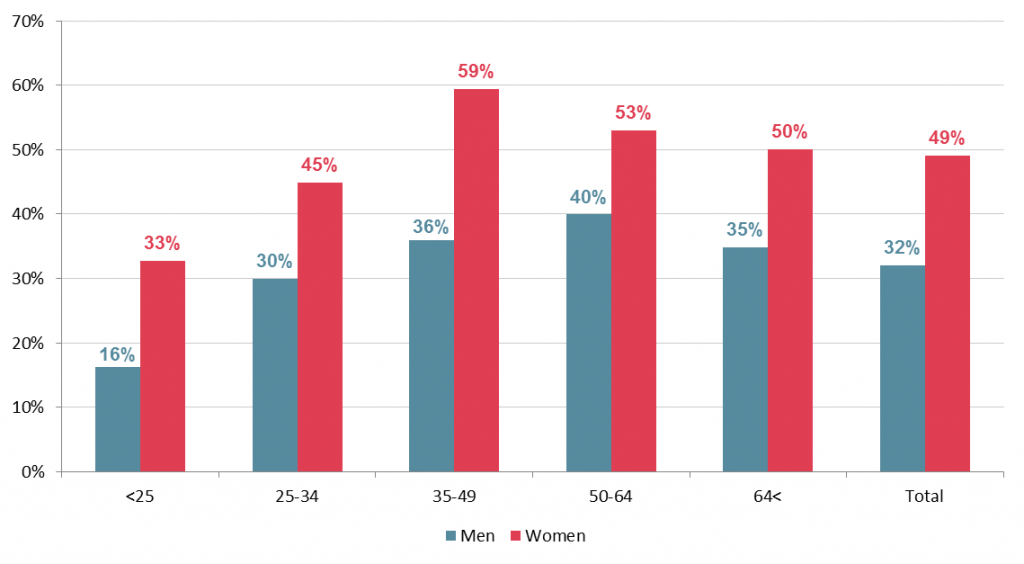Over 8.3 million Australians buy vitamins, minerals and supplements

Amid news that pharmaceuticals such as Blackmores and Swisse can begin labelling some of their products with the coveted “Australian Made” logo, the latest findings from Roy Morgan show that while demand has been increasing overall as a result of population growth, the proportion of Australians buying vitamins, minerals and supplements has gone down since 2014.
Of the people who purchase vitamins, minerals and/or supplements in 2018, 65% of them purchased them from pharmacies and chemists, such as Chemist Warehouse, My Chemist or Priceline, while 27% purchased their vitamins, minerals and supplements from supermarkets.
In December 2014, the number of Australians who purchase vitamins, minerals and/or supplements in an average 6 months increased from just under 8 million to over 8.3 million in 2018. However, as a proportion of Australia’s growing population, demand has dropped slightly from 41.2% in 2014 to 40.7% in 2018.
Women are still comfortably the largest purchasers of vitamins, with just under half of all Australian women (49.1%) having purchased vitamins, minerals and/or supplements in an average 6 months, compared to 32% of men.
The demographic for which vitamins, minerals and supplements are purchased at the highest rate are women aged 35-49 (59%), followed by women aged 50-64 (53%), while men under 25 are the least likely demographic to buy vitamins, minerals and/or supplements at only 16%.
Purchased vitamins in the last 6 months: Women cf. men by age

Source: Roy Morgan Single Source (Australia), January 2018 – December 2018 (n=14,913).
Michele Levine, CEO, Roy Morgan says:

“Despite ongoing medical debate about whether vitamins actually work, a large proportion of Australians are still buying them, with pharmacies and chemists their favourite place of purchase. Chemists have long been the most popular place to buy vitamins, minerals and supplements, with supermarkets being the next most popular option, offering customers higher convenience but at the cost of a smaller range than that offered by chemists.
“Growth in this market has stagnated in recent years, trailing behind population growth as pharmaceutical companies struggle to find larger demand in the domestic market.
“Whether recent developments surrounding “Australian Made” packaging rights for Australian vitamin manufacturers such as Blackmores and Swisse can improve local sales remains to be seen, however demand does appear to be holding steadily in the vitamin, minerals and supplements industry with women aged 35-49 years old and older a key market.
“In fact the Roy Morgan data shows that women are far more likely than men to buy these product across all age groups. Brands wanting to target these key markets need to know more about potential customers than just their age and gender.
“Factors such as attitudes to health and diet, family circumstances and socio-economic status, exercise participation and education all contribute to a consumer’s vitamin-purchasing decisions, and any brand that tailors its marketing campaigns accordingly will be better placed for success. This level of consumer insight can only be offered by Roy Morgan.”
For comments or more information please contact:
Roy Morgan - Enquiries
Office: +61 (03) 9224 5309
askroymorgan@roymorgan.com
Margin of Error
The margin of error to be allowed for in any estimate depends mainly on the number of interviews on which it is based. Margin of error gives indications of the likely range within which estimates would be 95% likely to fall, expressed as the number of percentage points above or below the actual estimate. Allowance for design effects (such as stratification and weighting) should be made as appropriate.
| Sample Size | Percentage Estimate |
| 40% – 60% | 25% or 75% | 10% or 90% | 5% or 95% | |
| 1,000 | ±3.0 | ±2.7 | ±1.9 | ±1.3 |
| 5,000 | ±1.4 | ±1.2 | ±0.8 | ±0.6 |
| 7,500 | ±1.1 | ±1.0 | ±0.7 | ±0.5 |
| 10,000 | ±1.0 | ±0.9 | ±0.6 | ±0.4 |
| 20,000 | ±0.7 | ±0.6 | ±0.4 | ±0.3 |
| 50,000 | ±0.4 | ±0.4 | ±0.3 | ±0.2 |
